Bigger and more practical than the outgoing model, the new
Page 34
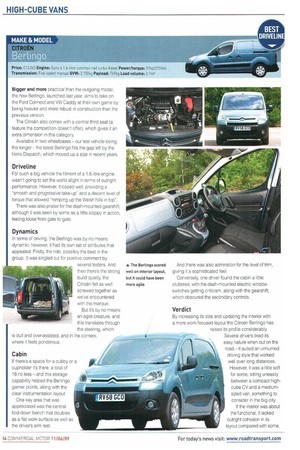
Page 35
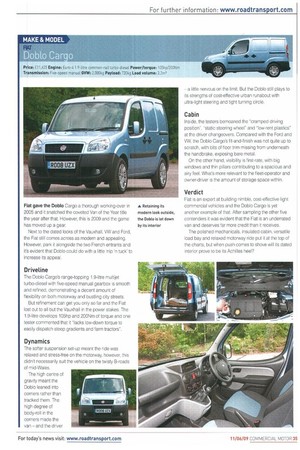
Page 36
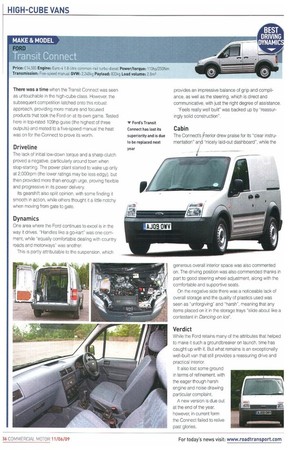
Page 37

Page 38
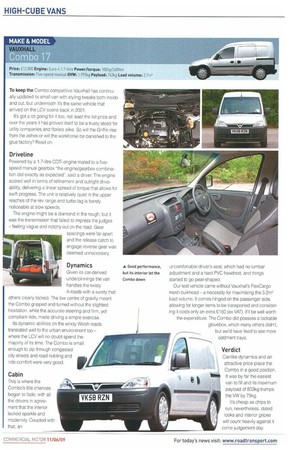
Page 39
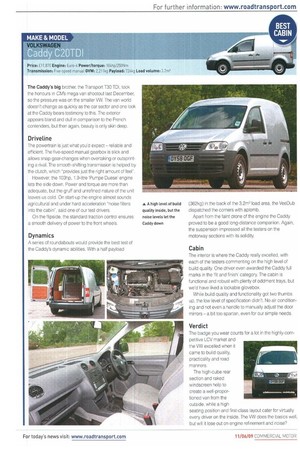
If you've noticed an error in this article please click here to report it so we can fix it.
Berlingo, launched last year, aims to take on the Ford Connect and VW Caddy at their own game by being heavier and more robust in construction than the previous version.
The Citroen also comes with a central third seat (a feature the competition doesn't offer), which gives it an extra dimension in this category.
Available in two wheelbases our test vehicle being the longer the latest Berlingo fills the gap left by the firm's Dispatch, which moved up a size in recent years.
Driveline
For such a big vehicle the fitment of a 1.6-litre engine wasn't going to set the world alight in terms of outright performance. However, it coped well, providing a "smooth and progressive take-up" and a decent level of torque that allowed "romping up the Welsh hills in top".
There was also praise for the dash-mounted gearshift, although it was seen by some as a Little sloppy In action, feeling loose from gate to gate.
Dynamics
In terms of driving, the Berlingo was by no means dynamic, however, it had its own set of attributes that appealed. Firstly, the ride, possibly the best in the group. it was singled out for positive comment by several testers. And then there's the strong build quality, the Citroen felt as well screwed together as we've encountered with the marque.
But it's by no means an agile creature, and this translates through the steering, which is dull and over-assisted, and in the corners, where it feels ponderous.
Cabin
If there's a space for a cubby or a cupholder it's there, a total of 16 no less and this storage capability helped the Berlingo garner points, along with the clear instrumentation layout.
One key area that was appreciated was the central fold-down bench that doubles as a flat work surface as well as the driver's arm rest. And there was also admiration for the level of trim, giving it a sophisticated feel.
Conversely, one driver found the cabin a little cluttered, with the dash-mounted electric window switches getting criticism, along with the gearshift, which obscured the secondary controls.
Verdict
By increasing its size and updating the interior with a more work-focused layout the Citroen Berlingo has raised its profile considerably.
Several drivers liked its easy nature when out on the road it suited an unhurried driving style that worked well over long distances.
However, it was a little soft for some, sitting uneasily between a compact highcube CV and a mediumsized van, something to consider in the big city.
If the interior was about the functional, it lacked outright cohesion in its layout compared with some. Fiat gave the Doblo Cargo a thorough working-over in 2005 and it snatched the coveted Van of the Year title the year after that. However, this Is 2009 and the game has moved up a gear.
Next to the dated looks of the Vauxhall, VW and Ford, the Fiat still comes across as modern and appealing. However, park it alongside the two French entrants and it's evident that Doblo could do with a little 'nip 'n tuck' to increase its appeal.
Drivetine
The Doblo Cargo's range-topping 1.9-litre multijet turbo-diesel with five-speed manual gearbox is smooth and refined, demonstrating a decent amount of flexibility on both motorway and bustling city streets.
But refinement can get you only so far and the Fiat lost out to all but the Vauxhall in the power stakes. The 1.9-litre develops 105hp and 200Nm of torque and one tester commented that lt "lacks low-down torque to easily dispatch steep gradients and farm tractors".
Dynamics
The softer suspension set-up meant the ride was relaxed and stress-free on the motorway, however, this didn't necessarily suit the vehicle on the twisty B-roads of mid-Wales.
The high centre of gravity meant the Doblo leaned into corners rather than tracked them. The high degree of body-roll In the corners made the van and the dryer a little nervous on the limit. But the Doblo still plays to Its strengths of cost-effective urban runabout with ultra-light steering and tight turning circle.
Cabin
Inside, the testers bemoaned the "cramped drying position", "static steering wheel" and "low-rent plastics" at the driver changeovers. Compared with the Ford and VW, the Doblo Cargo's fit-and-finish was not quite up to scratch, with bits of floor trim missing from underneath the handbrake, exposing bare metal.
On the other hand, visibility is first-rate, with big windows and thin pillars contributing to a spacious and airy feel. What's more relevant to the fleet-operator and owner-driver is the amount of storage space within.
Verdict
Fiat is an expert at building nimble, cost-effective light commercial vehicles and the Doblo Cargo is yet another example of that. After sampling the other five contenders it was evident that the Fiat is an underrated van and deserves far more credit than It receives.
The polished mechanicals, insulated cabin, versatile load bay and relaxed motorway ride put it at the top of the charts, but when push comes to shove will its dated interior prove to be its Achilles heel? There was a time when the Transit Connect was seen as untouchable in the high-cube class. However, the subsequent competition latched onto this robust approach, providing more mature and focused products that took the Ford on at its own game. Tested here in top-rated 109hp guise (the highest of three outputs) and mated to a five-speed manual the heat was on for the Connect to prove its worth.
Driveline
The lack of initial low-down torque and a sharp clutch proved a negative, particularly around town when stop-starting. The power plant started to wake up only at 2,000rpm (the lower ratings may be less edgy), but then provided more than enough urge, proving flexible and progressive in its power delivery.
Its gearshift also split opinion, with some finding it smooth in action, while others thought it a little notchy when moving from gate to gate.
Dynamics
One area where the Ford continues to excel is in the way it drives. "Handles like a go-kart" was one comment, while "equally comfortable dealing with country roads and motorways" was another.
This is partly attributable to the suspension, which provides an impressive balance of grip and compliance, as well as the steering, which is direct and communicative, with just the right degree of assistance.
"Feels really well built" was backed up by "reassuringly solid construction".
Cabin
The Connect's kterior drew praise for its "clear instrumentation" d "nicely laid-out dashboard", while the ai generous overall interior space was also commented on. The driving position was also commended thanks in part to good steering wheel adjustment, along with the comfortable and supportive seats.
On the negative side there was a noticeable lack of overall storage and the quality of plastics used was seen as "unforgiving" and "harsh", meaning that any items placed on it in the storage trays "slide about like a contestant in Dancing on Ice".
Verdict
While the Ford retains many of the attributes that helped to make it such a groundbreaker on launch, time has caught up with it. But what remains is an exceptionally well-built van that still provides a reassuring drive and practical interior.
It also lost some ground in terms of refinement, with the eager though harsh engine and noise drawing particular complaint.
A new version is due out at the end of the year, however, in current form the Connect failed to relive past glories. Being the newest contender in the group the Renault Kangoo had the development advantage over the rest of the gang. However, the company decided not to bump up the latest version in size, preferring to offer a smaller version as well. This put it at a disadvantage when it came to dimensions compared with the competition, but would the drivers mind?
Drive Line
Having the smallest engine didn't prove to be a problem in terms of performance — the 1.5-unit provided a good spread of power from low-down. That said, it did lack overall refinement, with several comments made on the engine's coarseness when pushed towards the red-line.
Nonetheless, the performance was bolstered by well spaced gear ratios from the six-speed box (a feature that wasn't present on several of its rivals), which also gained approval for its precise and short operation.
Dynamics
Its less than imposing looks made it appear a little timid compared with is rivals, yet the Kangoo surprised testers with its performance on the road. Comments included "decent dynamics on the tight and twisties, complete with minimal body roll", which were bolstered by "responsive steering and brakes".
The combination of quick steering, decent body control and damping made the Kangoo an entertaining drive, feeling nimble along the tighter roads.
Cabin
The cab drew praise for its simple and uncluttered design. It was easy to navigate and though small in terms of rear-seat travel it felt spacious due to its light colour scheme and generous width, which allowed for decent footwell space.
There was less praise for the airplane-style handbrake, which obscured the central cupholder, and the excessive noise levels.
The verdict
The Kangoo was very much the dark horse, however, it drew in a fan base thanks to its well-rounded design. Never the outright winner in any particular category, its steady performance meant it finished strongly, not least at the pumps.
Gruff engine aside, it gained praise for its overall driving ability thanks to a compliant and forgiving chassis that soaked up varying road types, together with accurate steering and a slick gearshift. And this was backed by a practical, if sparse, cabin.
For some, its dimensions left it wanting when stacked up against the competition, with the Renault lacking a heavyweight feel. To keep the Combo competitive Vauxhall has continually updated its small van with styling tweaks both inside and out, but underneath it's the same vehicle that arrived on the LCV scene back in 2001.
It's got a lot going for it too, not least the list price and over the years it has proved itself to be a trusty steed for utility companies and florists alike. So will the Griffin rise from the ashes or will the workhorse be banished to the glue factory? Read on.
Driveline
Powered by a 1.7-litre CDTi engine mated to a fivespeed manual gearbox the engine/gearbox combination did exactly as expected", said a driver. The engine scored well in terms of refinement and outright driveability, delivering a linear spread of torque that allows for swift progress. The unit is relatively quiet in the upper reaches of the rev range and turbo lag is barely noticeable at slow speeds.
The engine might be a diamond in the rough, but it was the transmission that failed to impress the judges — feeling vague and notchy out on the road. Gear spacings were far apart and the release catch to engage reverse gear was deemed unnecessary.
Dynamics
Given its car-derived underpinnings the van handles the twisty A-roads with a surety that others clearly lacked. The low centre of gravity meant the Combo gripped and turned without the slightest hesitation, while the accurate steering and firm, yet compliant ride, made driving a simple exercise.
Its dynamic abilities on the windy Welsh roads translated well to the urban environment too — where the LCV will no doubt spend the majority of its time. The Combo is small enough to zip through congested city streets and road holding and ride comfort were very good.
Cabin
This is where the Combo's title chances began to fade, with all the drivers in agreement that the interior lacked sparkle and modernity. Coupled with that, an uncomfortable driver's seat, which had no lumbar adjustment and a hard PVC headrest, and things started to go pear-shaped.
Our test vehicle came without Vauxhall's FlexCargo mesh bulkhead — a necessity for maximising the 3.2m3 load volume. It comes hinged on the passenger side, allowing for longer items to be transported and considering it costs only an extra £150 (ex VAT), it'll be well worth
the expenditure. The Combo did possess a lockable glovebox, which many others didn't, but we'd have liked to see more oddment trays.
Verdict
Car-like dynamics and an attractive price place the Combo in a good position. It was by far the easiest van to fill and its maximum payload of 803kg trumps the VW by 79kg.
It's cheap as chips to run, nevertheless, dated looks and interior gripes will count heavily against it come judgement day The Caddy's big brother, the Transport T30 TDi, took the honours in CM 's mega van shootout last December, so the pressure was on the smaller VW. The van world doesn't change as quickly as the car sector and one look at the Caddy bears testimony to this. The exterior appears bland and dull in comparison to the French contenders, but then again, beauty is only skin deep.
Driveline
The powertrain is just what you'd expect — reliable and efficient. The five-speed manual gearbox is slick and allows snap gear-changes when overtaking or outsprinting a rival. The smooth-shifting transmission is helped by the clutch, which "provides just the right amount of feel.
However, the 103hp, 1.9-litre 'Pumpe Duese' engine lets the side down. Power and torque are more than adequate, but the gruff and unrefined nature of the unit leaves us cold. On start-up the engine almost sounds agricultural and under hard acceleration "noise filters into the cabin", said one of our test drivers.
On the flipside. the standard traction control ensures a smooth delivery of power to the front wheels.
Dynamics
A series of roundabouts would provide the best test of the Caddy's dynamic abilities. With a half payload
(362kg) in the back of the 3.2m3 load area, the VeeDub dispatched the corners with aplomb.
Apart from the faint drone of the engine the Caddy proved to be a good long-distance companion. Again, the suspension impressed all the testers on the motorway sections with its solidity.
Cabin
The interior is where the Caddy really excelled, with each of the testers commenting on the high level of build quality. One driver even awarded the Caddy full marks in the 'fit and finish' category. The cabin is functional and robust with plenty of oddment trays, but we'd have liked a lockable glovebox.
While build quality and functionality got two thumbs up, the low level of specification didn't. No air conditioning and not even a handle to manually adjust the door mirrors — a bit too spartan, even for our simple needs.
Verdict
The badge you wear counts for a lot in the highly-competitive LCV market and the VW excelled when it came to build quality, practicality and road manners.
The high-cube rear section and raked windscreen help to create a well-proportioned van from the outside, while a high seating position and first-class layout cater for virtually every driver on the inside. The VW does the basics well, but will it lose out on engine refinement and noise?
















































































































































